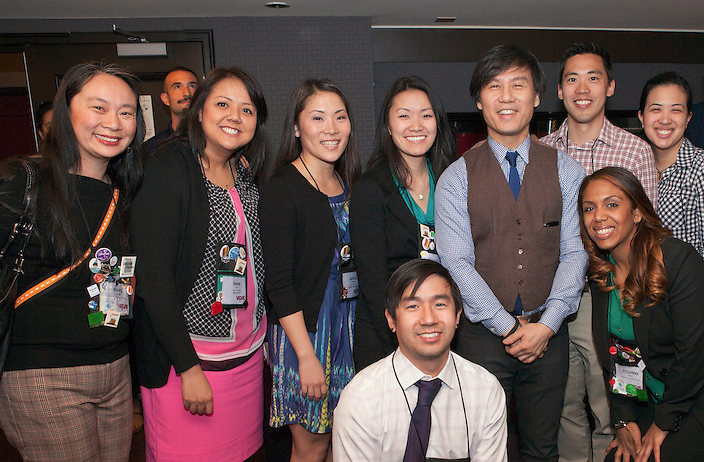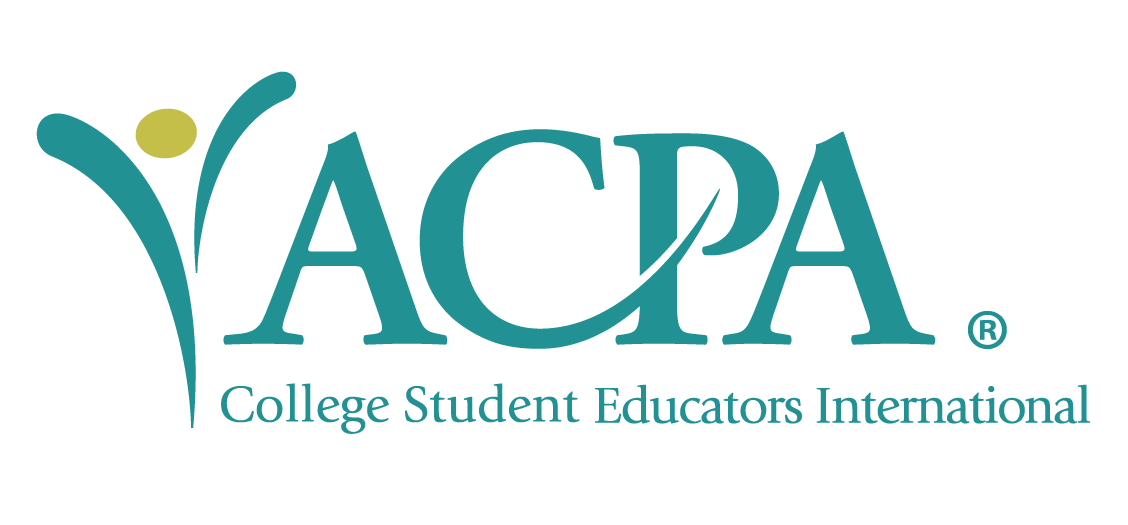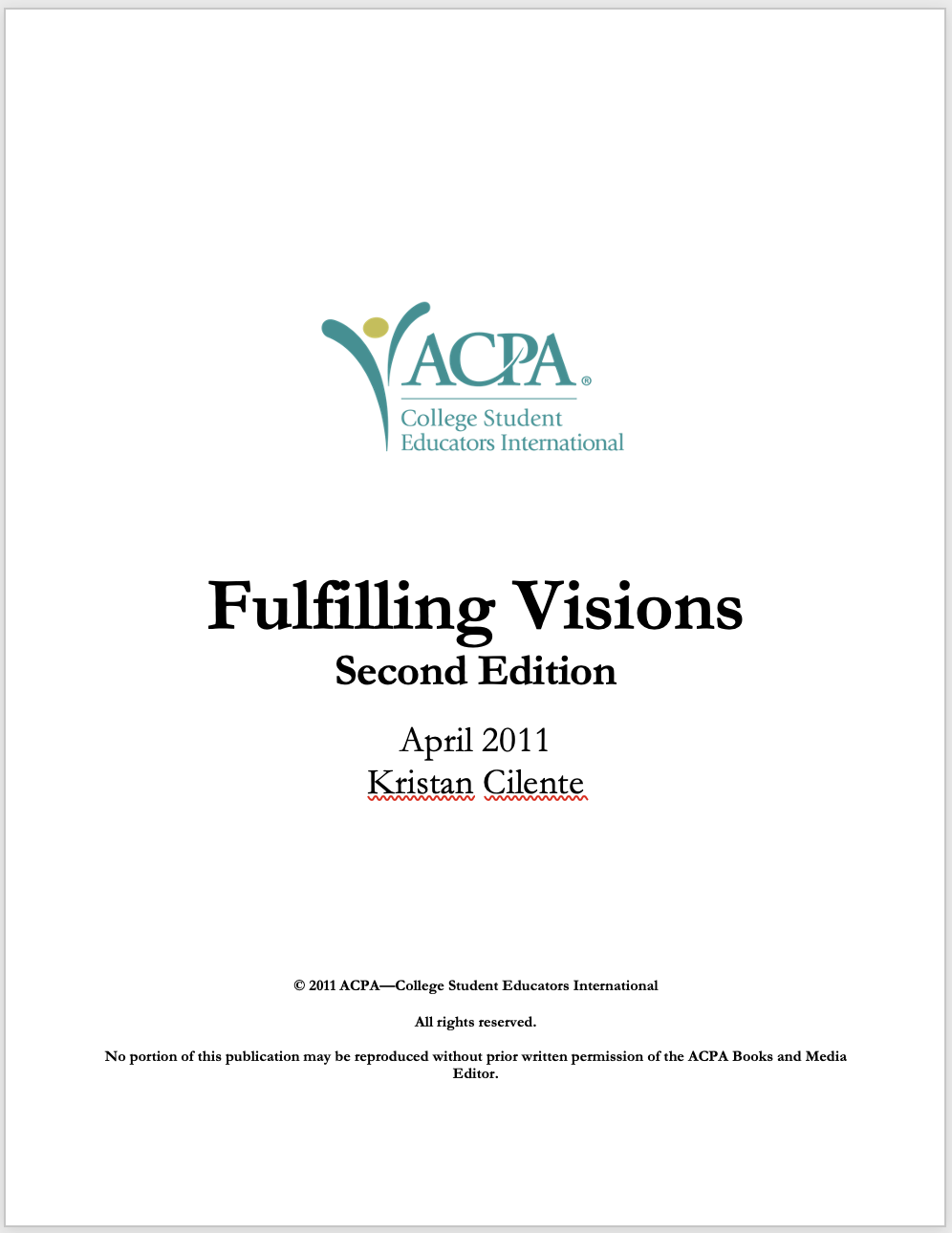The History of ACPA
“ACPA Has Always been Boldly Transforming Higher Education”
ACPA traces its beginnings to May L. Cheney who organized a teacher placement office at the University of California, Berkeley, and who became the first president of ACPA’s predecessor, the National Association of Appointment Secretaries (NAAS), in 1924.
Called “Appointment Secretaries” because they helped graduating students find appropriate positions, nine of them established NAAS in Chicago at the organizational meeting held during the annual educators’ convention. They came as guests of the National Association of Deans of Women (NADW) to this convention sponsored by the Department of Superintendence of the National Education Association (NEA). Each paid annual dues of $2.00 in 1924–25 and agreed to a common purpose to promote and develop the work of appointment offices throughout the country, emphasizing cooperation, research and service.
By 1929, forty-six NAAS members registered for the sixth annual convention and they produced a booklet entitled the “Cleveland Meetings on Personnel, Guidance, and Placement.” Then President Francis F. Bradshaw stressed the importance of the coordination of efforts of organizations interested in these areas. He stated that the name NAAS no longer covered the work responsibilities of its members and suggested the word “personnel” be substituted because it was more comprehensive. NAAS became the National Association of Personnel and Placement Officers (NAPPO). Two years later, in 1931, the name American College Personnel Association (ACPA) was adopted. Two important organizational purposes were formulated: to establish “sections within the national organization that would deal with different kinds of personnel work” and to focus “on the promotion and development by various means of people engaged in personnel responsibilities at the college level.” Under the leadership of Jack E. Walters, membership grew to 128. Several of the early ACPA presidents were also leaders in the emerging field of “college personnel,” including, Esther Lloyd-Jones, E.G. Williamson and C. Gilbert Wrenn.

Association communication consisted of one Newsletter mailed in 1937–38, followed by the Personnel- O-Gram and then the Journal for Educational and Psychological Measurement (EPM) in 1943. In 1952, the Personnel and Guidance Journal (P-O-G) replaced EPM as ACPA’s official journal. Charles Lewis, the P-O-G associate editor, was named the first editor of the Journal of College Student Personnel in 1959. In January 1988, it was renamed the Journal of College Student Development. Other ACPA presidents who formerly served as Journal editors were Robert Callis, Robert D. Brown and Laurine E. Fitzgerald.
The founding relationship between NAAS and NADW continued at annual conventions of NEA groups through 1942 when the conventions were discontinued due to World War II. In 1947, when these conventions were reconvened, ACPA and NADW were two of five or six major guidance organizations no longer connected with NEA. Then ACPA President, Daniel D. Feder’s recommendations for more formal unification efforts led to the formation of the American Personnel and Guidance Association (APGA). NADW voted to remain autonomous but ACPA members approved the plan to form APGA and became Division #1 on July 1, 1952.
During the next thirty years, ACPA flourished under the presidential leadership of outstanding student affairs practitioners and academic preparation program faculty members such as Catherine N. Northrup, Melvene D. Hardee, Elizabeth A. Greenleaf, Paul A. Bloland, Theodore K. Miller, Anne S. Pruitt, Don G. Creamer, Phyllis Mable, Cynthia S. Johnson, David T. Borland, Susan R. Komives, Margaret J. Barr, William A. Bryan, Dennis C. Roberts, and Marvalene Hughes, among many other dedicated presidents. Membership numbered 1,000 in 1952 when ACPA became a division of APGA and it increased steadily during the 50’s, 60’s and into the 70’s. At the close of 1976, membership totaled 9,384, an all-time high. At the 1995 Boston Convention, which attracted 3,800 attendees, total ACPA membership was 6,500. Today, membership averages 8,500 individual and 500 institutional members.
Several coordinated national conventions were held: in Cleveland in 1973—ACPA and NAWDC (name changed in 1956 from NADW); in Chicago in 1974—ACPA, NAWDAC (name changed from NAWDC in 1973) and the National Association of Student Personnel Administrators (NASPA, established in 1918 as the National Association of Deans and Advisors of Men, NADAM). In 1987, ACPA and NASPA met again in Chicago to celebrate the golden anniversary of The Student Personnel Point of View statement developed under the auspices of the American Council on Education (ACE) in 1937 with involvement of leaders from all three student affairs organizations. ACPA and NASPA held another joint conference in Chicago in 1997 and again in Orlando in 2007.

In 1983, ACPA was incorporated under the District of Columbia Non-Profit Act, under the leadership of Susan R. Komives, Margaret J. Barr, and William A. Bryan. In the spring of 1991, after forty years, ACPA leaders and members voted to disaffiliate from AACD (previously APGA), later renamed the American Counseling Association (ACA). This separation became effective on September 30, 1992. ACPA moved into new office space at the National Center for Higher Education at One Dupont Circle, NW in Washington, D. C. Presidents Leila V. Moore, Terry E. Williams, Charles C. Schroeder, Barbara Anderson and Harold E. Cheatham were all involved in this tremendous undertaking. Since then, the association has focused on developing new paradigms to improve and increase student learning.
ACPA continues to be recognized for its leadership in addressing issues and trends in student affairs within the context of higher education. Its mission, defined in its new strategic plan, is to support and foster college student learning through the generation and dissemination of knowledge, which informs policies, practices, and programs for student affairs professionals and the higher education community.
Our core values remain:
- Education and development of the total student;
- Diversity, multi-cultural competency and human dignity;
- Inclusiveness in and access to association-wide involvement and decision-making;
- Free and open exchanges of ideas in a content of mutual respect;
- The advancement and dissemination of knowledge;
- The continuous professional development and personal growth of student affairs educators; and
- A sustained program of outreach and advocacy on behalf of students.
In July, 2007 a new governance structure was implemented to carry out strategic plan initiatives.
ACPA celebrated its Diamond Anniversary Convention in Atlanta on March 20-24, 1999 with over 3,800 attendees. Highlights included the Senior Scholars Future Trends for Higher Education, the Practice Agenda Project and the ACPA Foundation’s Diamond Honoree Campaign.
In 2000, ACPA’s largest convention was held in Washington DC with its theme “2000 and Beyond: Capitalizing on Leadership, Scholarship and Citizenship”. Over 4,600 attendees enjoyed the capital city and program excellence.
The 77th Annual Convention was held in 2001 in the midst of the largest Nor’easter to hit Boston in decades. Fortunately, it arrived after most of the 4,600 registrants were already on site. Thirty-six inches of snow had been hauled away by the time Keynote Carlos Cortez closed this memorable convention. It was an excellent setting to discuss and exhibit “Complex Issues and Courageous Actions” and networking opportunities were never better.
In 2002, 3,400 attendees shared in the theme “Voices of Wisdom: Stories of Inclusion, Practice, and Scholarship” in beautiful Long Beach, California. This conference was uplifting and inspirational despite the fact that fewer could come in the aftermath of the devastating events of September 11, 2001. Those who experienced Anna Deavere Smith’s dramatic opening, the R. M. S. Queen Mary reception, the two-year college programs, and shared their stories about campus events in this fateful year were professionally and personally renewed.
ACPA embarked on a strategic planning process to carry the Association forward after achieving the goals it set for itself at the time of its disaffiliation in 1992. A decade as an independent association witnessed ACPA’s recognition as a member of the Higher Education Secretariat, a consortium of over fifty higher education organizations that meet monthly to share ideas and impact Congressional action in Washington, D. C.; the initiation of institutional dues to discount individual dues for campus members and help them maintain their professional development through ACPA’s excellent publications, new workshops and continuing institutes. These benefits also include the Mid-Level Management Institute; SSAO Institute, the launching of About Campus in 1996; the practitioner magazine that has become as renowned as ACPA’s scholarly Journal of College Student Development, the premier journal of the profession. ACPA’s individual memberships had grown to over 8,000 and its reserves to over $1M. There has been the development of Professional Competencies and Assessment Skills and Knowledge documents.
In 2002, Carmen Neuberger announced her retirement as Executive Director, effective June 30, 2003. The Executive Committee of the Council interviewed candidates in Spring 2003 and named Gregory Roberts, Executive Director and Senior Operating Officer effective September 1, 2003.
Since 2003, ACPA has continued to grow and develop as an organization. The past six years have been transformational for the organization. With the expansion of the state and international divisions within the Association, ACPA added a tagline to better reflect its purpose and membership to ACPA-College Student Educators International. Additionally, the international office staffing has grown to meet the expanding needs of members. With new membership types (undergraduate and graduate), commissions, standing committees, state divisions, and international divisions, ACPA continues to serve student affairs educators around the world.
In addition to the growth of staff and in membership, ACPA entered the 21st century with cutting-edge technology and outstanding new professional development resources. In partnership with NASPA, ACPA published Learning Reconsidered and Learning Reconsidered 2 as resources for campuses developing learning outcomes. Assessment Skills and Knowledge (ASK) Standards were published in 2007 and the Professional Competencies in 2009. Furthermore, ACPA’s commitment to educators is evident with the success of many new professional development opportunities such as; the Mid Level Management Institute, Residence Curriculum Institute, the Leadership Educators Institute, the Institute on Sustainability, the conference on Multiracial and Multiple Identities, and the Senior Student Affairs Officers Symposium.
One of the most significant changes in the past five years is the creation and implementation of a new governance structure. During President Jeanne S. Steffes’ first term in 2004-2005, the Governance Task Force, chaired by Patricia Perillo, began a three-year process of researching, creating, and implementing a new governance structure. The new Governing Board convened July, 2007 and the Assembly met at the Summer Leadership Meeting, moving ACPA into its next phase as an organization.
In 2009, ACPA celebrated its 85th Anniversary in Metro-DC at the Gaylord National Harbor. At that same convention the Journal of College Student Development celebrated its 50th year of publication, and the ACPA Foundation was recognized for 15 years of fundraising to support research, scholarship, professional development and leadership initiatives. The Council on the Advancement of Standards in Higher Education was recognized for 30 years of improving professional practice.
In 2011 ACPA and NASPA conducted a historic vote for possible consolidation. On April 27, 2011, it was announced that 42% of eligible ACPA voters participated in the vote and 81% of those voted in favor of a new association. Similarly, 42% of eligible NASPA voters participated, while only 62% of those voted in favor of a new association, short of the 2/3rds majority legally necessary to dissolve a non-profit in the District of Columbia.
In 2013, ACPA co-located the annual convention with NIRSA: Leaders in Collegiate Recreation in Las Vegas, Nevada. In 2014, ACPA hired Cynthia H. Love, Ed.D as the Executive Director.
Over the next few years, the International Office in Washington, D.C. downsized to a smaller physical footprint at the National Center for Higher Education in One Dupont Circle, and moved to a model where all employees are given the option to telework a few days a week. Some employees work completely remotely outside of the Washington, D.C. area.
In 2016, ACPA’s Annual Convention was held outside the United States for the first time in Montreal, Quebec, Canada. The partnership of CACUSS (the Canadian Association of College and University Student Services) was crucial to the convention being a huge success.
In late 2016 ACPA President Donna A. Lee introduced the Strategic Imperative for Racial Justice to the Association, following a strategic planning retreat held by the Governing Board and Assembly Leadership in Alexandria, VA.
In September 2017, Executive Director Cindi Love announced her intention to depart at the end of her contract term. The Governing Board named Chris Moody as Acting Executive Director effective in December 2017 and as permanent in the role as of January 2019.
ACPA’s ability to adapt, grow, and change throughout its almost 100 year history is a testament to its commitment to serving student affairs educators and will continue as ACPA enters the next century as an association.
Portions adapted from
Fulfilling Visions: Emerging Leaders of ACPA by Vernon Lee Sheeley, 1990
Fulfilling Visions (2nd Ed): ACPA from 1991-2010 by Kristan Cilente, 2011
Fulfilling Visions (3rd Ed): ACPA from 2011-2024 by Christopher Moody and Tricia Fechter Gates, 2024



